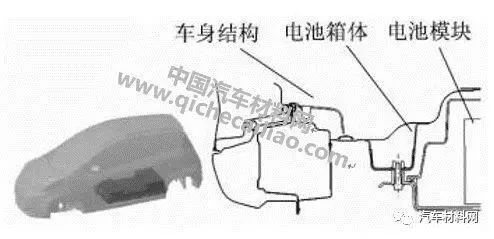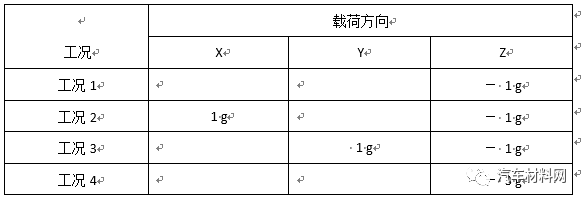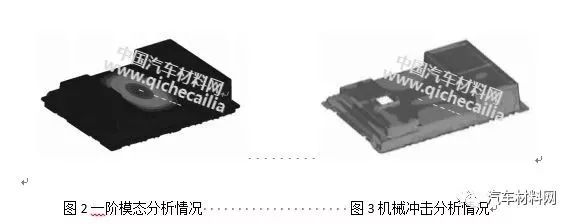In this paper, a pure electric vehicle is taken as the research object, combined with the characteristics of carbon fiber composite material design, the carbon fiber power battery box is designed to meet the demand of lightweight battery. Improve sensor power or add a front-end amplifier to achieve.
introduction
The development of new energy vehicles is an important way to effectively alleviate energy and environmental pressures and promote the sustainable development of the automobile industry. As the core component of the energy supply of new energy vehicles, the power battery directly affects the performance of new energy vehicles.
The power battery box acts as a carrier for the power battery and plays a key role in the safe operation and protection of the power battery. Most of the traditional electric vehicle power battery cases are made of metal materials. With the development of manufacturing materials, in order to improve the economics of new energy vehicles and realize the lightweight of power batteries, composite materials are gradually applied to power box design.
In this paper, a pure electric vehicle is taken as the research object, combined with the characteristics of carbon fiber composite material design, the carbon fiber power battery box is designed to meet the demand of lightweight battery. Improve sensor power or add a front-end amplifier to achieve.
1. Design of carbon fiber battery box
1.1 The functional requirements of the battery box for the product
As a protective part of the power battery for electric vehicles, the battery case has high requirements on structural design and weight. After the weight and size of the battery module are determined, there are many factors to consider when designing the battery case. First, the battery case is the carrier of the battery module through which the battery module needs to be connected. Secondly, the power battery is generally installed in the lower part of the vehicle body. Considering the working environment of the battery module, the battery box body needs to have the protection function for the module, and it is necessary to consider the waterproof and dustproof of the module and the corrosion of the battery box in the road environment. It is also necessary to consider the vibration and shock during the operation of the vehicle.
1.2 Advantage analysis of carbon fiber materials
The requirements of the material of the power battery box are: high strength; lightweight; excellent corrosion resistance? Carbon fiber has great advantages in these three aspects. First, the carbon fiber composite has high specific strength (tensile strength of the material and The ratio of density) and specific modulus (ratio of elastic modulus to density of the material), the specific strength is 5 times that of steel. The density of carbon fiber and epoxy resin after compounding is 1.4kg/m3. The material also has excellent properties. Corrosion resistance and flame retardancy?
1.3 Process design of carbon fiber battery box for vehicle
Carbon fiber composite products are molded in a variety of ways. Among them, the processing technology for carbon fiber battery cases is molded. Vacuum assisted molding (VARI)? RTM, etc. Molding? RTM process is suitable for large parts. VARI Process Institute The mold cost is low, the fiber content of the molded product is high, but the whole process of molding takes a long time. It is suitable for the production of parts with small batch requirements and low cost. According to the requirements of parts production and cost, combined with existing domestic composite material manufacturers. The process capability, comparing these three processes, this product chooses the VARI process?
VARI is a process for vacuum-assisted introduction of dry fabrics. The principle of the process is to coat the single-sided rigid mold with a flexible vacuum bag film. The fiber-reinforced material is sealed and the gas in the cavity is removed by vacuum vacuum. The resin is used to impregnate the fiber and its fabric by vacuum negative pressure driving resin. The process of the battery box is: a female mold, the surface is polished or matt, and a certain number of carbon fiber cloth is laid on the mold. After that, the mixed resin material is sucked into the fiber cloth by the vacuum pump through the auxiliary of the deflector, the guide tube, and the sealing strip, and finally solidified. After solidification molding, demoulding, and cutting and processing the boundary and the parts that need to be opened?
1.4 Structural design of carbon fiber battery box
The position of the power battery on the vehicle body is shown in Figure 1.

1.4.1 Overall structural design
According to the shape and arrangement of the battery module, combined with the position of the power battery on the vehicle body, the outer envelope of the battery box is designed to be close to a square box structure in accordance with the principle of utilizing space as much as possible.
The main structural layer is made of carbon fiber cloth and is supplemented with a resin. A metal joint is used at the joint, and the metal joint and the main structural layer are connected by a structural adhesive. Metal fasteners are used to connect the battery module group to the cabinet.
In order to increase the strength and mode of the part, on some large-area structural faces, the rib is a typical form to improve the structural stability, while the hat-shaped rib is relatively high in carrying efficiency and low in weight, and the battery case is adopted. Structures such as hat-shaped ribs and ribs are reinforced. In view of the characteristics of the continuous fiber composite material, the carbon fiber reinforced structure has a thick design at the ribs and the ribs.
1.4.2 ply design
The carbon fiber woven fabric of the battery case is made of T300-3K and T300-12K, and the two kinds of woven fabrics are mixed, and a total of 10 layers of carbon fiber plain weave fabric and resin are designed. The following considerations are mainly considered in the lamination: the balance of the ply angle, the number requirements of the same ply direction, the symmetry of the ply, the deviation of the angle between the plies, and the maximum number of continuous plies. The battery case parts are cross-tiled by 10 layers of plain weave, and the layering method is [0 /45 /0 /45 /0 /0 /45 /0 /45 /0].
1.4.3 connection design
The battery module needs to be connected to the vehicle body through the battery box body. The battery box body is connected by metal fasteners at the joint. These fastener parts are embedded in the way, and the joint can be withstood by controlling the depth of the buried portion. High tensile strength; some fasteners and carbon fiber body are bonded together by structural adhesive.
2. Analysis of simulation results of carbon fiber power battery box
The carbon fiber power battery box simulates and analyzes the structure of the power battery box from four aspects of G-Load, modal analysis, vibration and shock, which provides reference for durability research and structural optimization of the power battery system.
2.1 G-Load analysis
According to the values ​​in Table 1, the power battery is loaded in four working conditions, mainly to investigate the battery system in the normal driving process of the vehicle, due to factors such as braking, turning, jumping, etc., the battery system is subjected to structural strength under load from different directions.
Table 1 G-Load Analysis Load Case Table

The analysis results show that the maximum stress under severe conditions is less than the allowable stress of the material, as shown in Table 2.

2.2 modal analysis
The modality is the natural vibration characteristic of the mechanical structure. The modal analysis is used to determine the vibration characteristics of the design structure or machine components, ie the natural frequency and mode shape of the structure. For the power battery case, the modal analysis mainly investigates the first six natural frequencies and vibration modes of the battery system structure.
Because the random vibration standard J2380 is in the Z-direction vibration requirement, the frequency range below 35-40 Hz belongs to the high vibration energy zone, so the battery package Z to the low-order mode should be as high as 35-40 Hz as much as possible. After modal analysis of the model, the results show that the first-order mode of the battery case structure is 61 Hz, which meets the requirements for low-order modes (see Figure 2).

2.3 Mechanical shock
The mechanical shock resistance of the power battery box structure is analyzed by the method specified in ISO16750. The shock pulse uses a half-sinusoidal pulse waveform with a peak acceleration of 500 m/s2 and a duration of 6 ms. The acceleration of the impact is performed in the six directions used. The analysis results show that the maximum stress of the battery tray and the casing is 76.5 MPa, which is much smaller than the allowable stress of the material (Fig. 3).
2.4 Vibration analysis
The vibration analysis of the power battery case is based on the standard in SAEJ2380. The mechanical vibration resistance of the power battery box structure is analyzed according to the method specified in SAE J2380. The results of the analysis show that the maximum stress of the battery tray and housing is much less than the allowable stress of the material. The carbon fiber battery housing meets the design requirements.
3, the conclusion
In this paper, the method of lightweight design of power battery box using carbon fiber composites is studied, and the design is verified by finite element simulation analysis. From the analysis results, the carbon fiber composite battery case fully meets the requirements in terms of structural mode, mechanical impact and structural fatigue. The carbon fiber composite power battery case has a design weight of 12kg, while the power battery case made of SMC composite material has a weight of 15.5kg and an overall weight loss of 3.5kg, which is a weight reduction indicator compared to a weight reduction of 22%.
With more than 15+ yrs rich MFG experience, you can definitely trust in and cooperate with.
Provide you with the supply of Personal Protective Equipment. to help you safely get back to your daily routine.
Our products include pulse Oximeter Finger, Forehead Thermometer, Automatic foam soap dispenser, etc.
Our strict quality control protocol thoroughly vets every aspect of production, storage, and shipments all the way way to our end customers.
nano spray gun, nano spray gun disinfectant, nano spray machine
TOPNOTCH INTERNATIONAL GROUP LIMITED , https://www.mic11.com